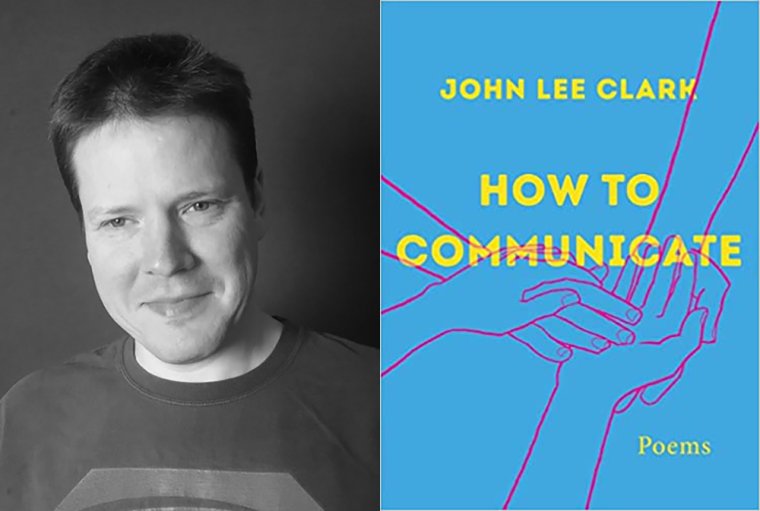This week’s installment of Ten Questions features John Lee Clark, whose poetry collection, How to Communicate, is out today from Norton. Charting the complex experience of living as a DeafBlind person in a world built for the hearing and seeing, How to Communicate considers the many ways we make and express meaning of the self, relationships, larger social systems, and nature. In a deft merger of structure and content, the book comprises prose poems, lyrics, forms derived from the Braille slate, and translations from American Sign Language and Protactile, a touch-based language, to explore the human drive to connect and its resultant pleasures and frustrations. As tonally dynamic as it is formally inventive, the verse braids aphorism—“The greenest pasture / Is always / The one / I am in”—with blunt confession: “I was the worst boyfriend imaginable.” Other poems drip with sarcasm and humor, particularly when lampooning the cluelessness of people outside the DeafBlind community: “Can’t I pick my nose / without it being a miracle?” the speaker asks a reporter in “Three Squared Cinquains.” Carl Phillips calls How to Communicate a collection of “formal virtuosity, of fierce tenderness, of triumphant community.” A National Magazine Award–winning essayist, historian, and translator who makes his home in Saint Paul, John Lee Clark is the author of Where I Stand: On the Signing Community and My DeafBlind Experience (Handtype Press, 2014). A 2021–2023 Bush Leadership Fellow, he travels and teaches extensively.

John Lee Clark, author of How to Communicate. (Credit: Adrean Clark)
1. How long did it take you to write How to Communicate?
My book is actually a collection of six smaller books: chapbooks, chaplets, sheaves, suites—call them what you may. The oldest one has poems culled from 2009–2011.
2. What was the most challenging thing about writing the book?
Finding food and shelter. Half of the book was written during an arduous time we had to move eleven times. I now realize it’s the same for my creative process, with the need to search, be on the move.
3. Where, when, and how often do you write?
At my desk all day every day, often joined by one of our two cats on my lap or nestled in a desk-bed next to my Braille display.
4. What are you reading right now?
I recently finished Maggie O’Farrell’s breathtaking memoir, I Am, I Am, I Am: Seventeen Brushes With Death. I am now back to my typical practice of rotating among multiple books until a book insists on keeping me straight through. A sample from my current rotation: Joy Harjo’s How We Became Human: New and Selected Poems 1975–2002; V. S. Naipaul’s A Bend in the River; Erin Manning’s For a Pragmatics of the Useless; Brian Massumi’s Parables for the Virtual: Movement, Affect, Sensation; and, for research, the wonderful, wonderful Vernon Lee—all her books and her multivolume selected letters.
5. What was your strategy for organizing the poems in this collection?
At first I let the poems pile up chronologically, oldest to newest. Eventually, though, feedback from friends helped me rearrange things. The second-newest group opens the book, for example.
6. How did you arrive at the title How to Communicate for this collection?
My friend Kaveh Akbar wasn’t impressed by the working title I had before. He went through the manuscript and made a list of alternatives. It was so helpful to encounter such a list! I thought that I didn’t want the title to have anything to do with “touch” or “hands”—too stereotypical. But I found that I did want to turn the go-against-the-grain impulse sideways.
7. What is one thing that surprised you during the writing of How to Communicate?
I often sit back and wonder how on earth I am going to outdo this latest poem—and start to worry that maybe it will be my last poem. There’s no point in writing another one if it’s not going to... Then, of course, I do write the next one: That’s the greatest shock of all.
8. What is the earliest memory that you associate with the book?
Autobiographically, the earliest reference in the book is connected with this particular memory: riding the short, yellow bus to school. This bus picked up Deaf kids and dropped us off at several different public schools that had small Deaf programs. None of the schools were the closest ones for any of us, as our parents had chosen different programs for different reasons. My parents wanted the one that supported American Sign Language the most, and that was an hour’s commute each way.
9. What forms of work, other than writing, did you have to do to complete this book?
Not really work, but swimming and knitting do have the effect of quieting the world and allowing ideas to come through.
10. What’s the best piece of writing advice you’ve ever received?
I was talking with Ilya Kaminsky about “po-biz.” He was rightly critical of how many American poets go about it. Without meaning to, he stabbed a phantom finger deep into my chest when he said, “Isn’t poetry supposed to be a spiritual practice?”








